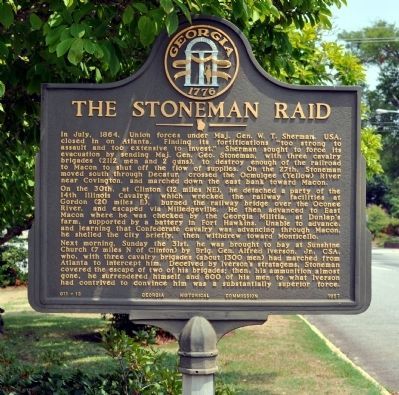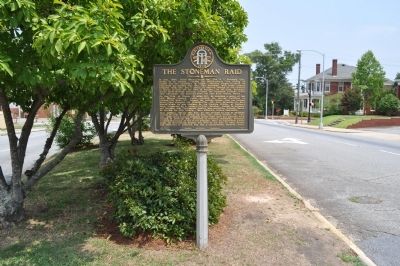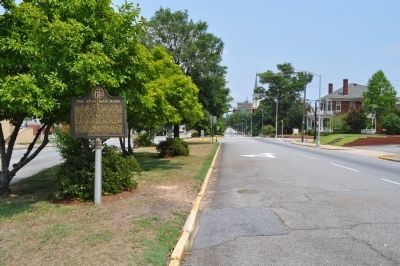Macon in Bibb County, Georgia — The American South (South Atlantic)
The Stoneman Raid
On the 30th, at Clinton (12 miles NE), he detached a party of the 14th Illinois Cavalry, which wrecked the railway facilities at Gordon (20 miles E), burned the railway bridge over the Oconee River, and escaped via Milledgeville. He then advanced to East Macon where he was checked by the Georgia Militia, at Dunlapís farm, supported by a battery in Fort Hawkins. Unable to advance, and learning that Confederate cavalry was advancing through Macon, he shelled the city briefly, then withdrew toward Monticello.
Next morning, Sunday the 31st, he was brought to bay at Sunshine Church (7 miles N of Clinton) by Brig. Gen. Alfred Iverson, Jr., CSA, who, with three cavalry brigades (about 1300 men) had marched from Atlanta to intercept him. Deceived by Iversonís strategies, Stoneman covered the escape of two of his brigades; then, his ammunition almost gone, he surrendered himself and 600 of his men to what Iverson had contrived to convince him was a substantially superior force.
Erected 1957 by Georgia Historical Commission. (Marker Number 011-13.)
Topics and series. This historical marker is listed in this topic list: War, US Civil. In addition, it is included in the Georgia Historical Society series list. A significant historical month for this entry is July 1864.
Location. 32° 50.399′ N, 83° 37.888′ W. Marker is in Macon, Georgia, in Bibb County. Marker is on Mulberry Street, 0 miles west of New Street, in the median. The marker stands in the median near the east-bound lane of Mulberry, just east of the crossover where the street narrows. Touch for map. Marker is in this post office area: Macon GA 31201, United States of America. Touch for directions.
Other nearby markers. At least 8 other markers are within walking distance of this marker. Civil War Era Maconites of African Ancestry (a few steps from this marker); Professional Building (within shouting distance of this marker); M. W. Grand Lodge of Georgia (within shouting distance of this marker); Fencing from Findlay Foundry (within shouting distance of this marker); Judge Asa Holt House (within shouting distance of this marker); Mulberry Street Methodist Church (about 600 feet away, measured in a direct line); The March to the Sea (about 600 feet away); P.L. Hay House (about 700 feet away). Touch for a list and map of all markers in Macon.
Credits. This page was last revised on June 16, 2016. It was originally submitted on July 12, 2011, by David Seibert of Sandy Springs, Georgia. This page has been viewed 938 times since then and 14 times this year. Photos: 1, 2, 3. submitted on July 12, 2011, by David Seibert of Sandy Springs, Georgia. • Craig Swain was the editor who published this page.


